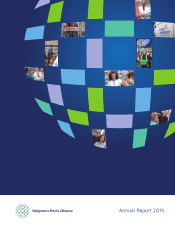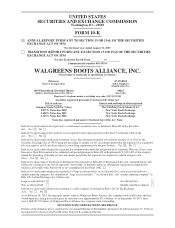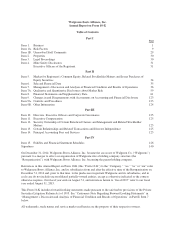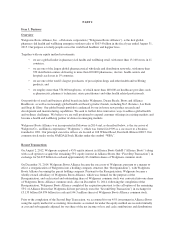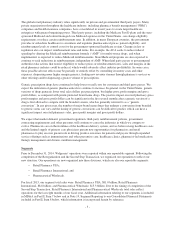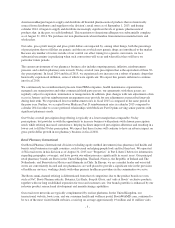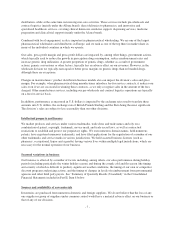Walgreens 2015 Annual Report Download - page 7
Download and view the complete annual report
Please find page 7 of the 2015 Walgreens annual report below. You can navigate through the pages in the report by either clicking on the pages listed below, or by using the keyword search tool below to find specific information within the annual report.
The global retail pharmacy industry relies significantly on private and governmental third party payers. Many
private organizations throughout the healthcare industry, including pharmacy benefit management (“PBM”)
companies and health insurance companies, have consolidated in recent years to create larger healthcare
enterprises with greater bargaining power. Third party payers, including the Medicare Part D plans and the state-
sponsored Medicaid and related managed care Medicaid agencies in the United States, can change eligibility
requirements or reduce certain reimbursement rates. In addition, in many European countries, the government
provides or subsidizes healthcare to consumers and regulates pharmaceutical prices, patient eligibility, and
reimbursement levels to control costs for the government-sponsored healthcare system. Changes in law or
regulation also can impact reimbursement rates and terms. For example, the ACA seeks to reduce federal
spending by altering the Medicaid reimbursement formula (“AMP”) for multi-source drugs, and when
implemented, is expected to reduce Medicaid reimbursements. State Medicaid programs are also expected to
continue to seek reductions in reimbursements independent of AMP. When third party payers or governmental
authorities take actions that restrict eligibility or reduce prices or reimbursement rates, sales and margins in the
retail pharmacy industry could be reduced, which would adversely affect industry profitability. In some cases,
these possible adverse effects may be partially or entirely offset by controlling inventory costs and other
expenses, dispensing more higher margin generics, finding new revenue streams through pharmacy services or
other offerings and/or dispensing a greater volume of prescriptions.
Generic prescription drugs have continued to help lower overall costs for customers and third party payers. We
expect the utilization of generic pharmaceuticals to continue to increase. In general, in the United States, generic
versions of drugs generate lower total sales dollars per prescription, but higher gross profit margins and gross
profit dollars, as compared with patent-protected brand name drugs. The positive impact on retail pharmacy gross
profit margins and gross profit dollars can be significant in the first several months after a generic version of a
drug is first allowed to compete with the branded version, which is generally referred to as a “generic
conversion”. In any given year, the number of major brand name drugs that undergo a conversion from branded
to generic status can vary and the timing of generic conversions can be difficult to predict, which can have a
significant impact on retail pharmacy sales, gross profit margins and gross profit dollars.
We expect that market demand, government regulation, third-party reimbursement policies, government
contracting requirements and other pressures will continue to cause the industries in which we compete to
evolve. Pharmacists are on the frontlines of the healthcare delivery system, and we believe rising healthcare costs
and the limited supply of primary care physicians present new opportunities for pharmacists and retail
pharmacies to play an even greater role in driving positive outcomes for patients and payers through expanded
service offerings such as immunizations and other preventive care, healthcare clinics, pharmacist-led medication
therapy management and chronic condition management.
Segments
Prior to December 31, 2014, Walgreens’ operations were reported within one reportable segment. Following the
completion of the Reorganization and the Second Step Transaction, we organized our operations to reflect our
new structure. Our operations are now organized into three divisions, which are also our reportable segments:
• Retail Pharmacy USA;
• Retail Pharmacy International; and
• Pharmaceutical Wholesale.
For fiscal 2015, our segment total sales were: Retail Pharmacy USA, $81.0 billion; Retail Pharmacy
International, $8.8 billion; and Pharmaceutical Wholesale, $15.3 billion. Due to the timing of completion of the
Second Step Transaction, Retail Pharmacy International and Pharmaceutical Wholesale total sales reflect
operations for the last eight months of our fiscal year. Additional information relating to our segments is included
in MD&A in Part II, Item 7 below and in Note 19, Segment Reporting to our Consolidated Financial Statements
included in Part II, Item 8 below, which information is incorporated herein by reference.
-3-

